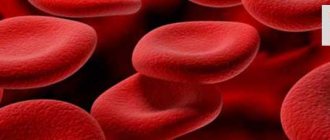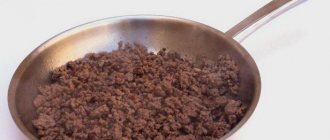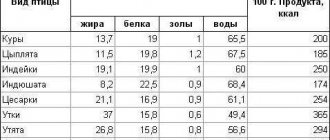The role of protein compounds for the human body
The role of polypeptides is very diverse. The main function should be noted as the construction role in human growth. They are the structural basis of all tissues of the human body - skin, bones, muscles. When playing sports related to muscle building, an increased supply of proteins should be ensured as a building material. An equally important transport role is the delivery of oxygen to the brain and other organs. Hormones and enzymes are made up of polypeptides, without which food cannot be digested. Finally, protein compounds form the basis of the immune system, which protects a person from the harmful influence of external and internal factors. Therefore, a lack of these beneficial substances can lead to dire consequences.
Food sources of proteins
Fruits that are high in protein
Protein intake rate
Amino acids that are necessary for humans are divided into two classes:
- replaceable - those that the body produces itself;
- irreplaceable - those that must be obtained from the outside.
In accordance with this division, polypeptides included in food products are divided into:
- complete (contain all essential amino acids) found in food of animal origin;
- inferior (do not contain all the necessary substances) are found in plants.
It should be noted that plant substances can be compensated by a combination of various products that complement each other to form a complete set of amino acids. An undoubted advantage is also that when eating plant foods, a person does not receive an excessive dose of fat as a supplement.
In terms of protein content, animal products are the undoubted leaders. However, plant foods can also act as a supplier of these beneficial substances. The ranking of the amount of such compounds in plant products looks like this:
- cereals, legumes;
- vegetables;
- fruits high in protein.
Plant foods are a source of proteins
Fruits high in protein.
Do fruits contain proteins? This article was written (translated) after I received several comments on the article “Nutrition for exocrine pancreatic insufficiency.” Here is the last verbatim comment: “Well, what kind of proteins come from fruits? Name these high protein fruits ."
To answer the question, I found and translated the article “The 15 Highest Protein Fruits” from Bembu.com, whose editor-in-chief is Dr. Carly Dolan.
And yet, some fruit names are active links that lead to articles on this blog. The author of the article did not have any links to the listed fruits.
Read.
Here are the top fruits that are highest in protein, ranked from highest to lowest.
Fruits are not generally known for their protein content, but there are some that are better than others when it comes to helping you increase your protein intake throughout the day.
In addition to their relatively small amount of protein, you'll be getting important vitamins and minerals.
Many of these vitamins act as powerful antioxidants in the body, strengthening the immune system and helping fight free radicals that are produced every day.
1. Dried apricots: 3.4 g protein (6% DV)
Apricots came out on top of this list, but they must be the dried variety since fresh apricots don't provide the same amount of protein.
You will find more than once that in most dried fruits their beneficial substances are concentrated, but the sugar content also increases.
Apart from the protein they supply to the body, apricots are also an excellent source of vitamin A, which acts as an antioxidant in the body to protect it from free radical damage, especially eye damage.
Apricots also contain ample amounts of potassium, which helps maintain healthy blood pressure levels.
The benefit of eating fruit in addition to your body's protein needs is that you will almost always get additional benefits from antioxidants and minerals, as well as fiber.
Tips for their use.
Chop up dried apricots and add them to your dishes or add them to high-protein cookies.
2. Raisins: 3.1 g protein (6% DV)
Raisins come in second and contain more protein than fresh grapes.
Their sweetness is often used in baked goods and snacks to provide nutrition, including added protein.
Raisins will help you with digestion and they are a source of calcium so you get support for your bones when you eat them.
Raisins are also a good source of iron and potassium, as well as a good source of fiber.
As with dried apricots and other dried fruits, you need to be careful with the total amount of sugar as they may contain more sugar than a medium-sized fresh fruit.
Tips for using them.
Add them to your oatmeal (oatmeal is also a good source of protein) or oatmeal cookies. It's also easy to take with you and use as a snack when you're on the go.
3. Guava: 2.6 g protein (5% DV)
Guava, you may not have eaten this fruit yet, but you need to know about it.
Of course, to rank number three on our list, guava would have to provide significantly more protein than other fruits, and it does, but this fruit has many other qualities that cannot be ignored.
When you eat guava, you will get lycopene, an antioxidant found in tomatoes.
Guavas actually contain more lycopene than tomatoes. And lycopene is an antioxidant against cancer.
Guava is also a good way to boost your immune system because it has a lot of vitamin C, much more than oranges, and even a small serving like half a guava will give you your daily dose of vitamin C.
Tips for use.
If you are not familiar with guava, they are easy to prepare for eating.
Simply wash them, cut them in half and slice them. It can be eaten raw or added to a fruit salad.
4. Dates: 2.4 g protein (5% DV)
Dates are a very good source of protein. They will provide you with approximately 5% of your daily protein requirement.
This isn't much compared to protein foods like chicken, but when used with other fruits and vegetables it will make a difference.
You help increase your potassium intake when you eat dates, which will help you avoid potassium deficiency, which can lead to a number of health complications.
When you eat dates, you also increase your fiber intake throughout the day, and they are a good source that will help you maintain your cholesterol levels and also stabilize your blood sugar levels.
Tips for use.
Dates are a portable snack that you can take with you and eat on the go. They are often used in baking to enhance flavor and natural sweetness.
5. Prunes: 2.2 g protein (4% DV)
Prunes are known for their fiber content and their ability to help maintain healthy weight.
But they are also fruits that contain proteins.
Taking a few prunes every day is a good habit, but like all dried fruits, they contain a lot of sugar, so be sure to limit your intake.
In addition to their protein content, prunes are also a good source of phenols, which can help you avoid cancer and help keep your heart healthy.
Their fiber content will help keep your blood glucose levels stable, which helps you maintain a healthy weight and avoid the onset of diabetes.
It is a small fruit with many beneficial benefits.
Whole prunes have more protein and potassium than prune juice.
Tips for use.
Prunes are light enough to be eaten as a snack on their own.
6. Avocado: 2 g protein (4% DV)
You might be surprised to find avocado on the list of protein fruits, but it beats many of its fruit relatives in terms of protein content.
Although you're probably familiar with avocados for their healthy fats.
But you shouldn't avoid avocados due to their high fat content.
These days we know that not all fats are created equal.
And the fat contained in avocados is what we should be getting to reduce body fat and as part of a nutritious and healthy diet.
Avocados have many benefits in addition to their proteins.
Tips for use.
Avocado is great for salads and for making guacamole. It can be eaten as a snack or added to smoothies.
7. Kumquat: 1.9 g protein (3% DV)
Many of us have never eaten a kumquat before.
These fruits contain more protein than many other fruits and are full of vitamins and phytonutrients that help the body in several ways.
Kumquats can be used as part of an anti-inflammatory diet designed to reduce symptoms of inflammation in the body.
They are also a good source of fiber and can give you an energy boost.
Kumquats aren't just a decent source of protein, they're also a good source of important vitamins like vitamin C, which will help your immune system.
Tips for use.
Kumquat is usually eaten as a raw fruit. You just need to wash it and put it in your mouth, and spit out the seeds.
8. Jackfruit : 1.7 g protein (3% DV)
It is possible that many of us have not yet tried this fruit.
Jackfruit is not only a good source of fruit protein, but it also has high levels of vitamin C and fiber, like many other fruits on our list.
One feature of jackfruit that you don't want to miss is its potassium content.
Like a banana, a serving of jackfruit will boost your potassium and help you reach your required daily intake.
Most fruits contain antioxidants.
Jackfruit is no exception, containing vitamin C as well as some vitamin A to help the body fight free radical damage.
Tips for use.
Preparing jackfruit can be labor intensive due to its large size and outer covering.
But it's worth the effort, at least sometimes it's worth adding a little variety to your diet and reaping the benefits this fruit provides as well as enjoying its sweet taste.
9. Currants : 1.4 g protein (3% DV)
Because of the bright red color of red currants, you can add a splash of color to your plate while adding protein, fiber, and important minerals to your diet.
Currants are loaded with fiber and will help you meet your fiber needs.
It's important to consider fiber along with protein because many high-protein foods are low in fiber.
Eating foods like currants that are a source of protein as well as fiber is a great way to supplement your protein intake and help your digestive system.
Currants also provide you with most of the vitamin C you need and are on par with the vitamin Cs you get from oranges.
Tips for use.
Because of the size and shape of the berries, you can sprinkle them on top of your salad or just pop them in your mouth.
The berries can also be made into jam and used in the same way as you would use jam from other berries.
10. Raspberries: 1.2 g protein (2% DV)
Raspberries certainly don't contain a lot of protein, but these berries will help contribute to your total protein grams taken in a day.
Raspberries and other berries are on the list of superfoods because of their antioxidant value, which fights free radicals.
Of course, you can't rely on raspberries alone to meet all your body's antioxidant needs, but when combined with other healthy foods, they will work to your advantage.
In addition to containing protein and antioxidants, raspberries are also a good source of fiber, so you get at least three big benefits from eating them.
Tips for use.
Raspberries go very well with yogurt and are a great way to start your day off right with protein because yogurt is also a good source of protein.
The tartness of both raspberries and yogurt makes them a complementary pairing.
11. Bananas: 1.1 g protein (2% DV)
Bananas contain enough protein to make our list of high-protein fruits, but keep in mind that they will only add a fraction of your recommended daily protein value.
There are other features of bananas that make them a smart choice as part of a protein-conscious diet.
They are well known for their potassium, which gives you a full 10% of what you need every day.
Besides potassium and protein, bananas will also help you replenish your fiber throughout the day.
Enjoying a banana every day can help you maintain a healthy weight, can lead to support for your digestive system, and because of the potassium it contains, can help keep your blood pressure levels normal.
Tips for use.
Bananas are the perfect snack for any snack, and they come with their own portable packaging.
They can be used to make banana bread, banana pancakes, ice cream, they can be added to oatmeal, smoothie to smooth it out and also increase its protein.
12. Peaches : 0.9 g protein (1% DV)
Peaches are delicious at the end of summer. And they can add protein to our food.
We get so much more than just protein with peaches.
Peaches are a source of beta-carotene, which helps our eye health as well as our immune system.
You can spot beta-carotene foods by their orange coloring. Carrots, sweet potatoes, melon and other foods also have an orange tint.
They are also a good source of fiber, which helps keep your digestive organs clean and non-toxic.
For this reason, you often see them included in diet and weight loss programs for the natural weight loss effect they provide.
Tips for use.
Peaches are difficult to keep fresh. But you can also buy them frozen. Then add peach slices to smoothies or a bowl of yogurt for even more protein.
13. Figs. 0.8 g protein (1% DV)
Whether you eat fresh figs or dried figs, you will get some protein from them as well as other nutrients that contribute to a healthy diet.
You can eat fresh figs or dried ones.
Dried figs will provide more protein per gram, but they also have a lot more sugar, which balances out the benefits you get from the protein.
Figs are also on the list of foods with the highest calcium content and are also a good source of potassium.
When dried, they are an excellent source of fiber, which will help you feel full and are a great addition to a high-protein diet.
Tips for use.
If you're not used to working with figs, it may take a little familiarization, but it's worth the effort.
Once you learn how to prepare them, you can use fresh figs in a variety of ways, from salads to appetizers and more.
14. Grapefruit: 0.8 g protein (1% DV)
Grapefruit has earned a reputation for being a health food, and it provides a modest amount of protein compared to other fruits on our list.
Overall, you'll reap many benefits from eating grapefruit, many of which outshine anything you'll get from its protein content.
Grapefruit can help with weight loss efforts, but you don't need to use it as part of any grapefruit diet or extreme weight loss plan.
Eating a grapefruit every day in the morning gets you off to a good start with added fiber, being a low-calorie food and providing you with the energy to get your morning off to a good start.
In addition to its weight loss and protein benefits, grapefruit is also a good source of vitamin C, as are most citrus fruits.
This will strengthen your immune system, making grapefruit an excellent fruit to sell in the winter when there is a danger of contracting the flu or other viruses.
Tips for use.
If you don't like the sour taste of grapefruit but don't want to add refined sugar to it, try half a teaspoon of raw organic honey spread over the top of half a grapefruit.
15. Cantaloupe: 0.8 g protein (1% DV)
Cantaloupe is a type of melon. One of the most delicious ways to increase your protein is to eat cantaloupe.
The sweet taste and soft texture make it a great addition to your menu.
But it still has many ways to improve your health.
Cantaloupe contains a lot of vitamin A and vitamin C.
This duo of two vitamins, which are powerful antioxidants, protects the human body from free radical damage and helps the immune system.
This orange-colored melon is a source of beta-carotene, an antioxidant that helps your vision as well as your immune system.
It also contains some fiber, which helps your digestive system.
Tips for use.
Cantaloupe is a great fruit to eat all summer long.
This fruit is delicious on its own, but can be mixed with other melons, such as honeydew, or watermelon for a delicious salad that will never leave you satisfied.
Link to the original source.
Translation by Galina Lushanova.
I hope now you know that fruits also contain protein, although they contain many more different substances that are beneficial to our health. Therefore, they must be in our diet.
Please write if this article was useful to you.
Fruits high in protein.
29 votes Average rating: 4.6 out of 5
Source of proteins
Which fish has the most protein?
It is clear that even fruits with a high protein content are not the most active supplier of amino acids. However, fruits contain protein, albeit in small quantities, so you should never neglect them. As a supplement to "get" the necessary amino acids, fruits containing protein will be of great benefit. Those who are on a weight loss diet should not forget that these representatives of the flora contain many other essential substances and microelements, and their low calorie content must also be taken into account. If you know which fruits contain protein, you can properly balance your diet.
Basic principles
For a fruit-protein diet to be effective, you need to follow its basic principles - the rules drawn up by nutritionists. If you simply eat in accordance with the recommendations, without auxiliary actions, you may not lose weight at all. The following tips will help speed up the process.
- You cannot combine proteins and fruits in one dish. This is the basic principle of not only this diet, but also separate nutrition.
- Alternate protein foods with fruits and berries: the main meals (breakfast, lunch, dinner) should include only proteins, the rest - only fruits. The exception is that some vegetables are allowed for lunch.
- Engage in sports, which, in combination with protein foods, will give you not only weight loss, but also sculpted body contours.
- Meat and fish should not be fried. It is better to stew, boil or steam them.
- Salt - in limited quantities.
- Avoid alcohol and smoking.
- Sleep should last at least 8 hours.
- You need to eat small portions, but often (6 times a day).
- Drink a glass of filtered water between meals.
- Throughout the entire fruit-protein diet, you need to take vitamins (preferably a complex).
- Walks in any weather: fresh air on fasting days will be a must.
The fruit and protein diet is not strict, but expert recommendations will speed up the weight loss process, making it more enjoyable and effective. The benefit to the body will also be determined by the correct exit from this diet.
On a note. If during the fruit-protein diet you begin to feel dizzy or feel a loss of strength, eat a little honey or a banana - they will “refuel” you with the necessary energy.
Where are the most proteins found?
Protein sources
Protein sources
So which fruits have a lot of protein? The TOP 5 list looks like this:
- dried apricots (and other dried fruits);
- dates;
- avocado;
- passion fruit;
- banana and kiwi (approximately equal amount of polypeptides).
Experienced nutritionists warn that you should be careful about providing the body with polypeptides.
To avoid irreversible consequences, strict vegetarians need to compose their menu so that it contains the full range of substances necessary for the body, be sure to include protein fruits in the diet. Non-strict vegetarians also should not neglect the quality of their diet and must ensure that the lack of animal proteins is compensated for by plant foods. For better absorption of polypeptides, doctors recommend receiving protein foods in the first half of the day.











